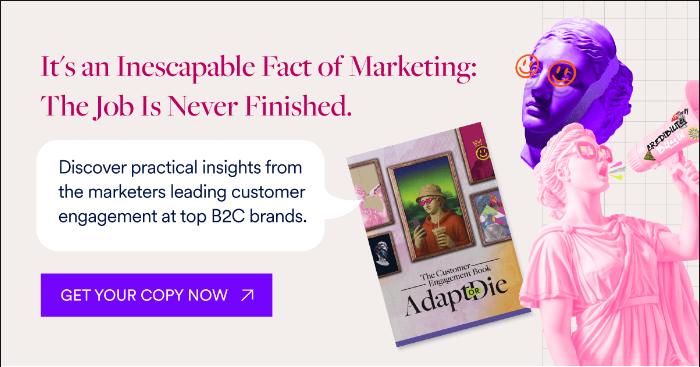A Master Guide to Ecommerce Customer Journey Strategy
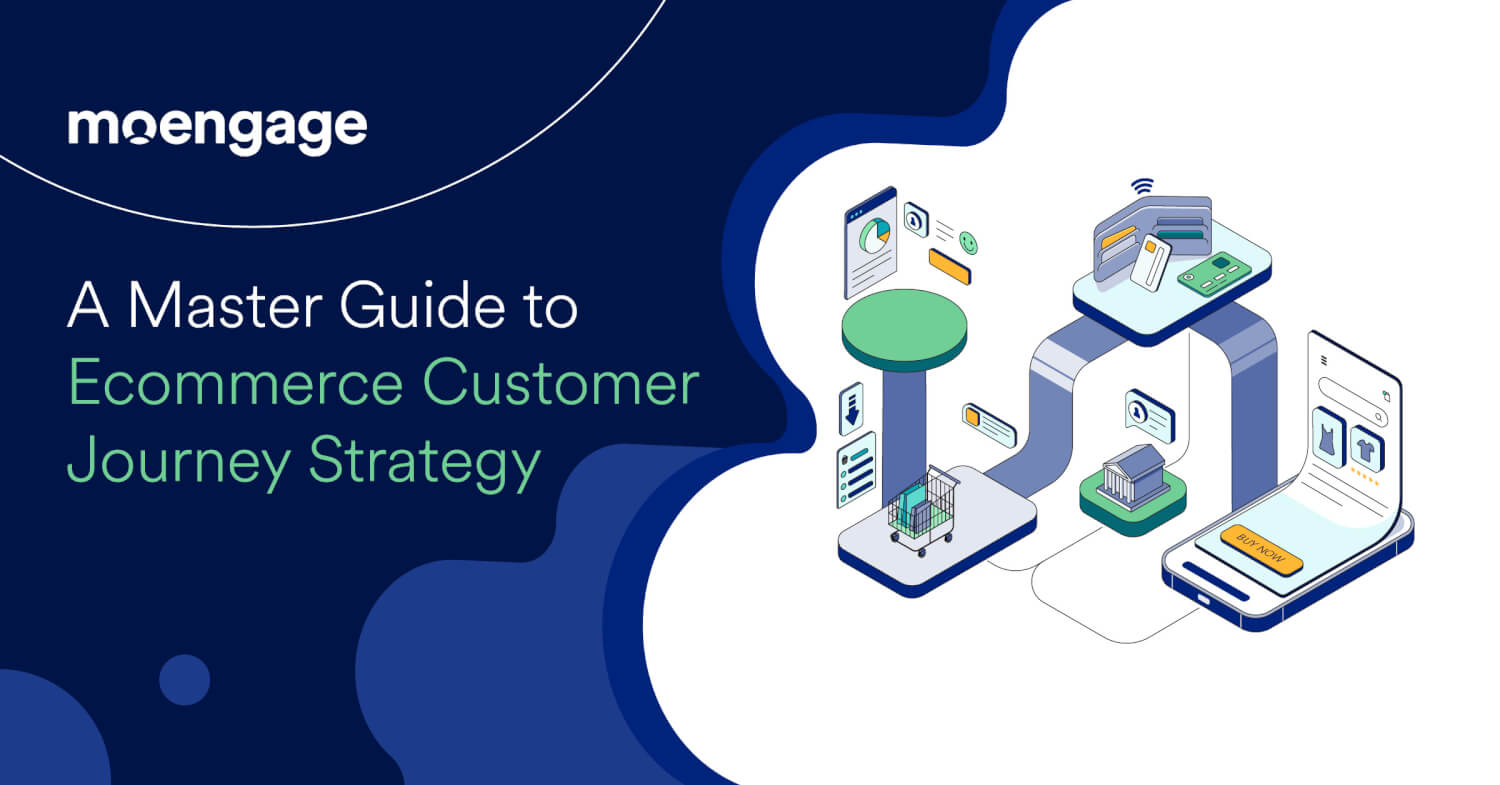
Reading Time: 11 minutes
Modern shoppers aren’t just looking for the best product, they’re also looking for the best customer experience — one they actually want to repeat.
But it’s no easy task to piece together the optimal experience for customers, especially when you have to create a familiar omnichannel experience that weaves online and offline touchpoints together seamlessly. This is even harder to get right for ecommerce brands that often serve large, diverse customer bases.
According to ecommerce and retail marketers, their biggest blind spot when building omnichannel experiences is identifying gaps in the customer journey, with 46% saying this was a major concern. Fortunately, customer journey mapping can illuminate these blind spots, enabling ecommerce brands to orchestrate seamless journeys that guide customers effortlessly through conversion funnels toward a purchase.
To help you fill any gaps and maximize engagement at every stage of the customer journey, we explore what ecommerce customer journeys are, how the five main stages apply in an ecommerce context, and the main tools you need to be able to map journeys accurately.
What is an Ecommerce Customer Journey?
An ecommerce customer journey refers to the end-to-end experience a customer has with a brand, from their first impression through to their final interaction. These journeys are often focused on conversions and re-conversions.
Ecommerce brands that understand how their customers explore and use their products are able to craft experiences that more effectively guide customers toward conversion events. For ecommerce, the primary conversion event is typically a purchase, but it can also be an app download, a membership sign-up, a repeat purchase, or a series of other customer actions that lead to more sales and revenue.
Why is an ecommerce customer journey different?
As one would expect, ecommerce brands are hyper-focused on conversions. This means they put special emphasis on acquiring new customers and driving them to make their first purchase.
More than other industries, ecommerce brands have found that the majority of their success doesn’t come from single purchases, but from loyal customers who make repeat purchases. After all, that’s what drives customer lifetime value (LTV), increases the efficiency of marketing spend, and ensures consistent revenue generation.
The retail and ecommerce space is highly competitive; with Amazon leading the US online retail space and other brands vying for customer attention amid a sea of competitors. Consumers have a wide array of options, and in the ecommerce space, these options are right at their fingertips. Access is simple and immediate; customers don’t have to travel to a competitor’s location and can change brands in just a few clicks. This makes it extremely difficult for ecommerce brands to not only attract — but keep — their customers’ attention.
Brands are also operating under strict time restraints, as the buying process is often very short. Customers shopping online typically prioritize speed and convenience; because of this, they often make faster, more impulsive purchase decisions. For ecommerce marketers, it means you have to react quickly to their actions and deliver effective messaging at the optimal time to engage them, or you risk losing their attention altogether.
Cross-selling and upselling are also integral to ecommerce brand’s success, more so than other industries. While media and entertainment companies that sell subscriptions need to simply retain the customer for longer to increase customer lifetime value (LTV), ecommerce brands need to drive up average order values (AOV) to meaningfully increase LTV, as their customers’ purchase behavior is often not consistent.
Furthermore, online shoppers expect their experiences and marketing communication to be personalized based on their past shopping activity and individual preferences. They’re looking for personalized product recommendations and communication that speaks to them; and if they fail to get it, they’ll look elsewhere.
The result is a highly competitive market for ecommerce brands looking to connect with customers that not only make a one-time purchase, but love your brand enough to advocate on its behalf. And for ecommerce brands to excel, they need to orchestrate seamless omnichannel experiences that engage them throughout the entire customer journey.
5 Ecommerce Customer Journey Stages to Consider
When mapping the customer journey, marketers typically break the customer journey down into five main stages — awareness, consideration, decision, retention, and advocacy.
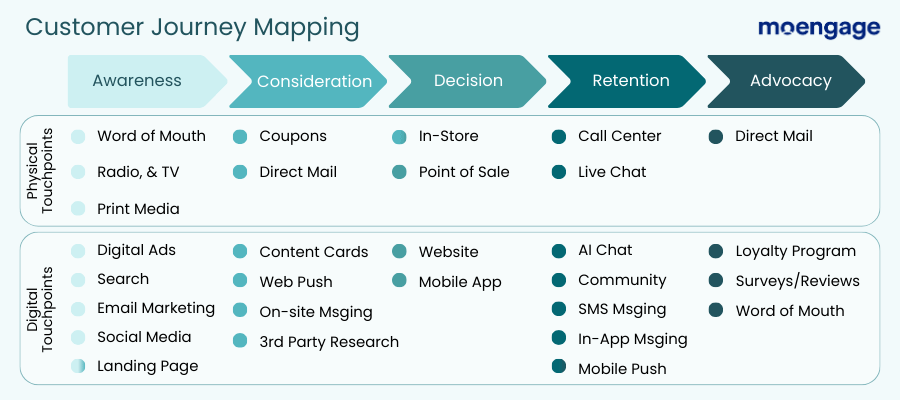
While the stages themselves don’t change from industry to industry, how they are applied certainly does. Below, we look at how ecommerce brands typically approach each stage of the customer journey differently from other industries.
| Customer Journey Stage | How This Stage is Different in Ecommerce |
| 1. Awareness: The customer becomes familiar with your brand. | Acquiring new customers is often the top priority of ecommerce brands, as it fuels revenue and growth. These brands need to increase exposure and develop brand recognition, while still reaching out to the right customers to optimize marketing spend. |
| 2. Consideration: The customer reviews product/service options from different brands. | Ecommerce brands have a uniquely short window of time at this stage, as the buying process is often very short. Aside from large purchases, customers spend limited time comparing options. To make sure you’re chosen, you need to quickly convey to your customers why you stand out against your competition. |
| 3. Decision: The customer makes a choice on what to purchase. | Online shoppers don’t deliberate for long, they are looking for a fast, convenient experience from brands, and are likely to make their decision quickly. You need to help them make that decision as fast as possible, and then enable them to act on it instantly. |
| 4. Retention: The customer continues using the product or service through repeat purchase(s). | Successful ecommerce brands understand that true success comes from customers who make repeat purchases, regularly engage with your brand, and choose you over your competition. Leading brands prioritize customer retention and building brand loyalty. |
| 5. Advocacy: The customer recomments the product/service to others. | Ecommerce brands looking to grow need their customers to become brand advocates that share their experiences externally and attract new customers through word-of-mouth. For this reason, ecommerce marketers are committed to delivering incredible experiences and invest heavily in post-purchase marketing campaigns and customer support. |
Strategies Using an Ecommerce Customer Journey Example
The customer journeys you create—and therefore the mapping process itself—won’t be the same for all brands, as they change based on industry, niche, etc.
To help identify how to craft a customer journey designed to help your ecommerce brand achieve its objectives, we’ll look at an example of a cart abandonment flow.
Cart abandonment is a never-ending struggle for ecommerce brands; studies show the average shopping cart abandonment rate is approximately 70%.
With customer journey mapping, ecommerce brands can create seamless cart abandonment flows that encourage customers to buy items they’ve previously shown an interest in. More importantly, brands can create multiple journey flows and test the performance of each to see what works most effectively for each customer.
For example, a brand could deploy two different cart abandonment campaign strategies to improve conversions:
Strategy A: Utilizing event-triggered campaigns
Maximum Conversion Rate Seen with MoEngage Customers That Used This Strategy: 39.7%
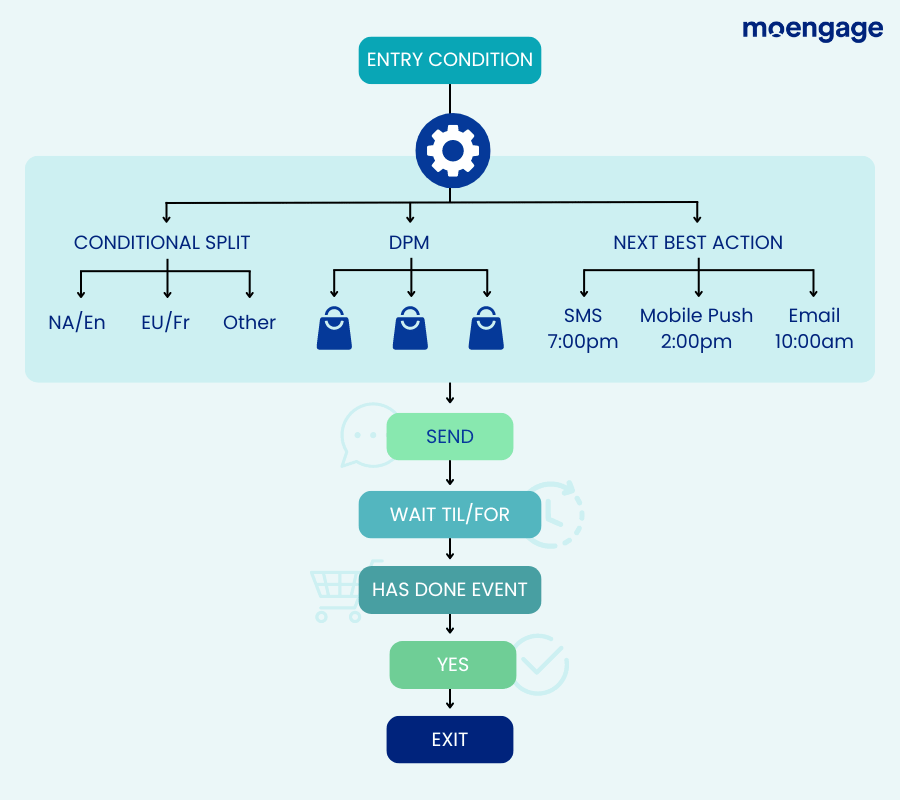
For this strategy, it is important to set up an event-triggered campaign, that gets activated the moment a customer abandons their cart. Applying NBA (Next Best Action) at this stage ensures you automatically send communication to each customer on their preferred channel at the preferred time. Also, set up a Conditional Split to segment your customers based on locality and language preferences. Lastly, use DPM (Dynamically Personalized Messaging) to customize the messages based on the actual products that were left in the abandoned cart, to enable deeper personalization.
By using event triggers and hyper-personalization to capture the attention of customers when they’re most likely to come back, you can turn potential lost sales into revenue.
Strategy B: Utilizing dynamic A/B testing
Maximum Conversion Rate Seen with MoEngage Customers That Used This Strategy: 29.18%
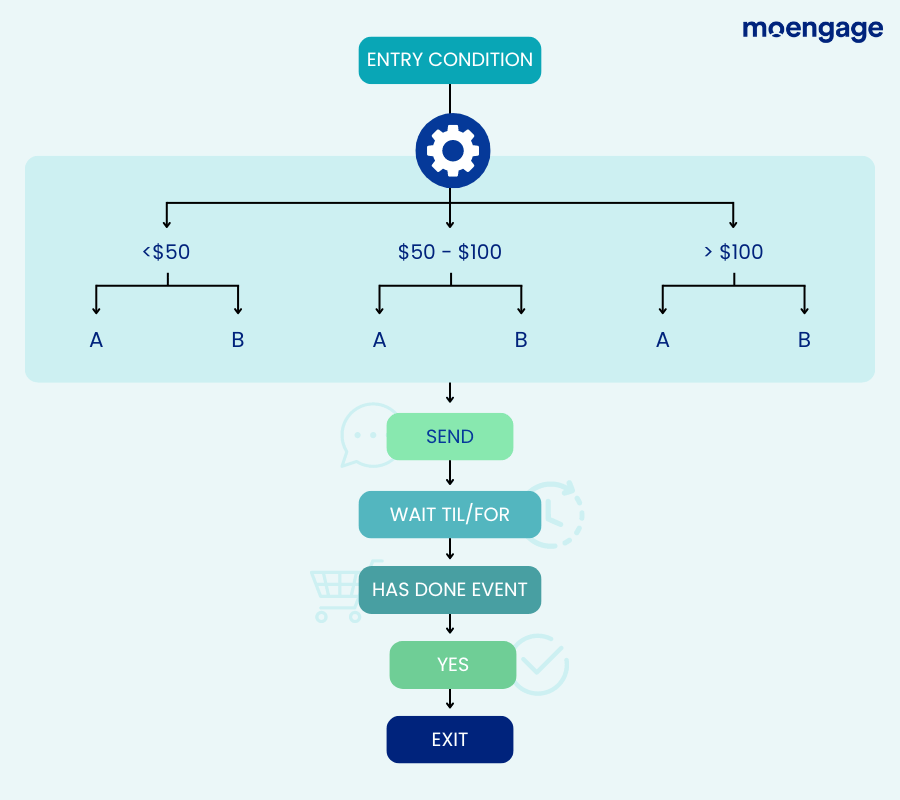
To implement this strategy, you need to set up a Conditional Split to segment cart-abandonment customers based on their lifetime value (LTV). Prioritize sending campaigns to higher-value customers. Also, use dynamic A/B testing to compare campaign variations to see what resonates most.
By optimizing your campaigns intelligently, and in real time, this strategy helps to create a feeling of FOMO and reignite your customers’ interest in the products.
| Note:
For both campaigns, set up Wait Till/For to control when a customer advances to the next stage of the campaign and ensure they aren’t served messages too early. Also, use Exit On Conversion to automatically remove customers from the flow after it’s completed, to prevent them from being spammed. |
For a comprehensive list of other ecommerce customer journey strategies, review our full guide on Strategies to Maximize ROI Through Ecommerce Customer Journey Marketing.
3 Ecommerce Customer Journey Tools and Techniques to Enable You
Now that you know how to use ecommerce customer journey mapping, let’s look at some of the tools and techniques you need to do it effectively and efficiently, to minimize spending and maximize profits. We’ll look at each below so you can understand how they should be used, where to deploy them in your process, and why they are so important for achieving marketing success.
1. Customer Journey Mapping
To be able to build the best customer journeys for your customers, you’ll need to understand how and where your customers interact with your brand and what touchpoints lead to conversions/re-conversions and drop-offs.
A customer journey map will help you build seamless customer journeys that guide customers towards particular conversion events, whether that’s a first-time purchase, a successful 25% upsell, or a 6 month period as an MAU. This allows you to visualize the entire process, and integrate your marketing campaigns seamlessly into the customer experience. It also helps you understand where to deploy specific features, in order to nudge customers to perform various actions.
By understanding and refining your customer journey, you’ll be able to improve the overall buying experience for customers, increasing engagement, conversions, and retention.
Consumers interact with ecommerce brands in various ways, and each interaction rarely follows the same path as the previous one. To ensure customers can engage via the optimal pathway each time, ecommerce brands will need to build customer journey maps for different use cases.
Here at MoEngage, we have designed various B2C journey mapping templates that brands like yours can instantly use and customize to their liking. These templates will empower you to orchestrate seamless customer journeys that effectively engage customers.
Why do ecommerce marketers need to do customer journey mapping?
Customer journey mapping is an integral first step in building seamless customer journeys for your customers. Without it, you’ll struggle to fit all the pieces together. It’s also critical for ensuring your omnichannel experiences stay relevant and up-to-date.
For ecommerce brands, customer journey mapping allows them to:
- Identify gaps in the customer journey: By visualizing the customer journey, ecommerce brands can identify missing pieces and discover reasons for drop-offs and customer churn. This helps them course-correct.
- Determine the best methods of engagement: Customer journey mapping makes it easy for ecommerce marketers to identify the best channels and campaigns to use to engage customers throughout their experience. Brands can then better leverage their marketing channels to funnel customers toward conversions.
- Create seamless customer experiences: Ultimately, mapping out customer journeys will enable you to build seamless customer experiences that let customers shop across online and offline channels effortlessly. It also ensures they get a familiar experience each time, so they know exactly what to look for (and how to add items to their cart!).
With a customer journey mapping tool, ecommerce brands can create customer journey maps that don’t just guide customers through to purchase but also deliver relevant, effective post-purchase communication and support.
2. Omnichannel Data Analysis
A customer journey map is a lot like a traditional map, it will only lead you in the right direction if it’s accurate and you’re reading properly.
It’s imperative that your customer journey map actually represents the ways your customers interact with your ecommerce brand, and considers all available pathways at their disposal. If you’re building customer journeys based only on how you want your customers to interact with your brand, you’re set up for failure.
Accurate, reliable, robust omnichannel analytics provide ecommerce brands a holistic view of how customers engage with their brand across all available touchpoints, painting a complete picture of their engagement patterns. This empowers brands to develop finely tuned experiences and campaigns that guide customers towards conversions.
Why do ecommerce marketers need to track customer analytics?
Detailed analytics enable you to track the performance of the journeys you create, allowing you to make adjustments to mitigate friction, increase traction, and maximize engagement at every step of the shopping journey.
Ecommerce brands that leverage omnichannel analytics will be able to:
- Segment customers based on spending habits: Detailed analytics enable ecommerce brands to engage customers based on their shopping behavior, buyer intent, and past spending habits. By better understanding customers’ wants, needs, interests, and preferences, you’re able to not only drive one-time conversions but retain customers for the long haul.
- Get actionable insights that matter: With detailed analytics data on customer behavior and activity patterns, brands are able to extract actionable insights that lead to meaningful improvements to their customer experience and campaigns. This allows them to focus their efforts where it will have the greatest impact on mitigating churn and optimizing customer LTV.
- Allocate resources to high-performing campaigns: Trustworthy, reliable data allows you to make confident, data-driven decisions about where to allocate your marketing budget and resources. Increase the value of every marketing dollar by doubling down on campaigns that are working and taking underperforming campaigns back to the drawing board.
The fact is, your analytics should guide your strategy, including how you choose channels, how you time messages, and what tone you use for your communication.
At MoEngage, we don’t believe in operating on instinct alone. That’s why our Customer Insights & Analytics platform helps ecommerce marketers make data-driven decisions that deliver experiences their customers are looking for.
3. Customer Engagement Platform (CEP)
A CEP is a tool that enables brands to execute their customer journeys—from planning to creation to deployment to optimization.
An omnichannel ecommerce CEP helps ecommerce marketers do their jobs more effectively by unifying analytics data, automating routine tasks, streamlining internal workflows and processes, and generally supporting the marketing team in achieving its objectives. Modern CEPs consolidate all omnichannel insights and allow brands to execute their engagement campaigns from a single space.
These tools not only house the data needed for brands to build customer journey maps, but they also provide the capability to implement them and course-correct them in real time.
Why do ecommerce marketers need a customer engagement platform?
CEPs empower modern ecommerce brands to deliver the fully integrated, seamless, omnichannel, personalized experiences their customers have come to expect.
Having a reliable CEP helps ecommerce brands achieve the following:
- Automate customer journey optimization: CEPs help brands orchestrate customer journeys more effectively by automating routine tasks. AI optimization can also be used to automatically improve channel selection, timing, frequency, and even messaging, ensuring that your campaigns resonate with customers. This is incredibly powerful for ecommerce brands that are struggling to serve a high volume of customers at scale.
- Act on real-time shopping behavior: A unified CEP provides comprehensive data on insights like traffic sources, conversions, and churn to maximize engagement, mitigate drop-offs, and ensure customers convert. It also lets you take immediate action to improve your campaign messaging and delivery.
- Build omnichannel journeys easily without code: With a no-code customer engagement platform, ecommerce marketers can limit engineering resources and turn shopping insights into conversion opportunities within minutes, instead of days. This empowers ecommerce brands to adapt quickly and effortlessly to major shifts in shopping trends and individual customer behavior.
Orchestrating omnichannel journeys is challenging enough for businesses with small customer bases. But for enterprise-level companies with diverse customer segments and a myriad of different products, it’s even harder to get it just right.
MoEngage’s enterprise-ready Customer Engagement Platform (CEP) allows you to tap into various analytics and extract insights that enable you to meet customers at every touchpoint along their journey and keep them engaged.
Enhancing Ecommerce Customer Journey Strategy with MoEngage
By mapping customer pathways for different use cases, ecommerce brands can close gaps in the customer journey and guide customers more smoothly toward conversions and similar events. Marketers can gain clarity on what drives customers at different stages of their journey, and identify ways to increase traction to mitigate churn and increase engagement.
And to make this process even simpler, a comprehensive CEP like MoEngage comes into play.
MoEngage helps you consolidate all customer journey tools, enabling your team to manage every element of the customer engagement process and implement various techniques to orchestrate flawless customer journeys.
To find out how MoEngage can help you build and execute customer journey maps for various ecommerce scenarios, schedule a demo to talk to our sales team.









